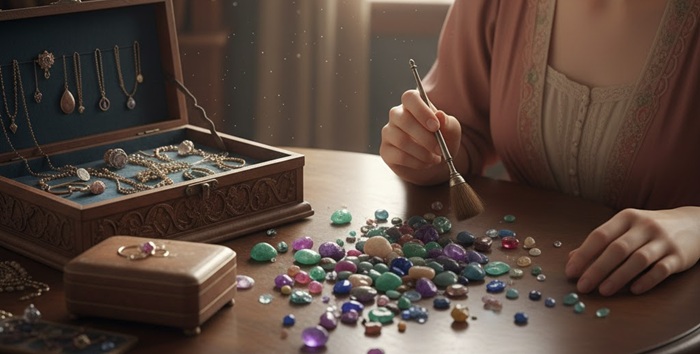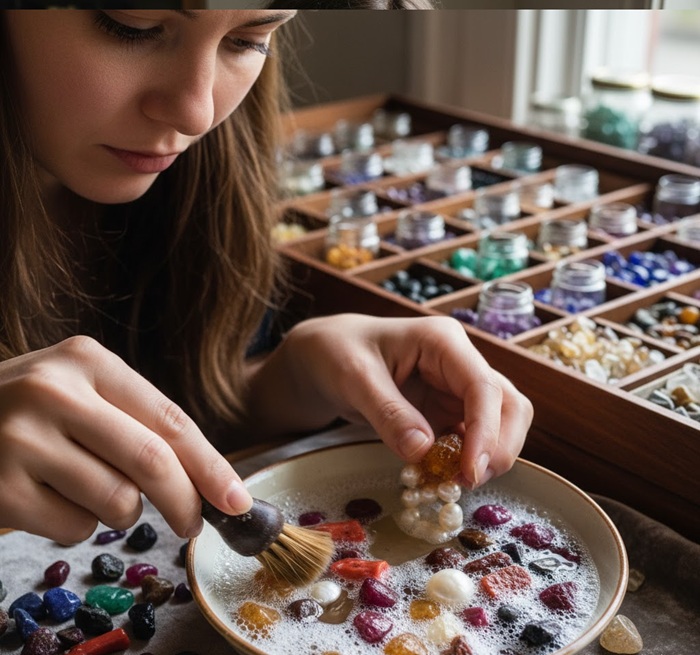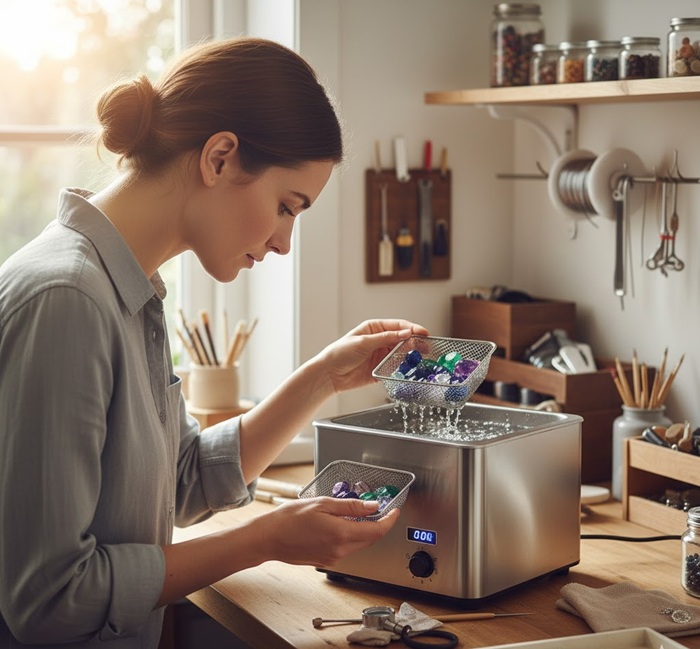
When you think of “ultrasonic cleaning,” you might imagine a futuristic little tub that magically transforms dull jewelry into dazzling brilliance.
And to a large extent — it does. But just because you can put a gemstone in that buzzing bath doesn’t mean you should.
Ultrasonic cleaners are powerful tools that use high-frequency sound waves to create microscopic bubbles in a liquid. These bubbles implode with enough force to shake off dirt, oil, and microscopic grime from even the tiniest crevices.
The process is called cavitation, and it’s fantastic for metals like gold, platinum, and stainless steel.
But for many gemstones? It’s a potential disaster.
The same vibrations that lift away grime can also loosen inclusions, crack delicate structures, or destroy fracture fillings that hold your gem together.
Let’s explore — in detail — which stones are unsafe for ultrasonic cleaning, why they react badly, and what you should do instead.
Gemstones You Should Never Clean Ultrasonically
Ultrasonic cleaners typically operate at frequencies between 20 kHz and 40 kHz.
The tank is filled with water or a mild cleaning solution, and when ultrasonic waves pass through it, they generate millions of microscopic cavitation bubbles.
These bubbles collapse at high speed, producing shockwaves that dislodge dirt and oxidation from jewelry surfaces.
This is ideal for hard, stable materials — like diamonds or pure gold. However, gemstones are not created equal.
Their internal structures, porosity, and treatments determine how they handle this mechanical stress.
So, if you are looking for those ultrasonically sensitive and vulnerable gems, here is a list:
1. Porous or Organic Stones
These stones are like sponges — they absorb liquids, oils, and dyes.
Ultrasonic waves can force moisture into their microscopic pores, causing discoloration, cracking, or even complete disintegration.
- Pearl – Organic, delicate, and layered like an onion. The vibration can loosen nacre or separate layers, dulling its luster.
- Coral & Amber – Both are organic and soft; the heat and vibration can cause cracking or color fading.
- Opal – Especially doublets and triplets. They contain thin layers glued together — the ultrasonic agitation can break the adhesive seal, causing the layers to delaminate.
- Turquoise – Extremely porous. It often contains stabilizing resin, which can break down when exposed to an ultrasonic bath.
- Malachite & Lapis Lazuli – Composed of soft minerals with visible pores. They can etch, absorb the solution, or even crumble along existing fractures.
Pro tip: If a gem’s beauty depends on moisture, resin, or wax, keep it far away from an ultrasonic cleaner.
2. Treated or Fracture-Filled Stones
Many modern gemstones undergo treatments to enhance their clarity or color.
Unfortunately, ultrasonic cleaning is a sworn enemy to those enhancements.
- Emerald – Almost every emerald is treated with oil or resin to fill fractures. Ultrasonic cleaning can boil out the oil, turning a vivid green gem into a cloudy, lifeless one.
- Ruby & Sapphire – Natural, untreated corundum is hard (Mohs 9) and usually safe. But lead glass-filled rubies are fragile; the filler can crack, leak, or cloud under vibration.
- Tanzanite – Heat-treated to achieve its iconic blue-violet hue. It’s brittle and has perfect cleavage — even slight vibration can split it.
- Topaz – Often coated or irradiated to achieve color. The coating can chip or peel off in ultrasonic agitation.
Before cleaning, always ask if the gemstone is treated — most jewelry retailers disclose it on purchase documents. If it’s fracture-filled or heat-treated, hand-cleaning is your safest option.
3. Stones with Natural Cleavage, Brittleness and Cracks
Some crystals, by nature, have internal “planes of weakness.” A strong vibration can travel through these planes like a miniature earthquake.
- Kunzite – Beautiful but notoriously fragile; its cleavage makes it prone to cracking.
- Fluorite – Soft (Mohs 4) and easily fractured. Ultrasonic cleaning can cause surface etching or total breakage.
- Zircon – High refractive brilliance, but brittle. The cleaner’s shockwaves can chip facets.
- Iolite & Moonstone – Both have directional cleavage; ultrasonic vibrations can split them along these planes.
Remember that even tough stones like diamonds or sapphires can be vulnerable if they contain internal cracks or inclusions.
Ultrasonic waves can travel through the stone and cause the inclusion to expand, leading to fractures.
Example: A diamond with a feather-type inclusion can develop additional fractures during ultrasonic cleaning, especially if the inclusion reaches the surface.
So, it’s better to avoid them for sonication.

Safer Alternatives to Ultrasonic Cleaning of Vulnerable Stones
Beware that for delicate or treated gems, manual cleaning is your best friend. So, if you are unsure, it’s good to believe your hands rather than machines…
- Mild Soap and Lukewarm Water: Mix a few drops of dish soap in water. Use a soft brush (like a baby toothbrush) to gently scrub the jewelry.
- Microfiber or Jewelry Cloth: Buff the surface gently to restore shine without abrasion.
- Professional Steam Cleaning (For Durable Stones Only): Jewelers sometimes use low-pressure steam for diamonds and sapphires — effective but only when appropriate.
- Jewelry-Safe Cleaning Solutions: Check that the solution label specifically says “safe for soft or porous stones.”
But before it comes to cleaning your jewelry, a few expert habits can save you from costly heartbreak.
First, always know your stone — if you’re unsure about its identity or any treatments it may have undergone, it’s better to skip the ultrasonic cleaner altogether.
Next, keep your jewelry away from sudden temperature changes. Heat can wreak havoc on sensitive gems like opals and emeralds, causing tiny fractures or even complete cracking.
Also, don’t overcrowd your ultrasonic tank — each piece needs enough space to vibrate freely.
When items knock against each other, those gentle bubbles can turn into a micro-battlefield of scratches and chips.
And finally, always read the label before using any commercial jewelry cleaner. Some formulas contain ammonia or harsh solvents that can dull or damage porous or treated stones.
A little caution here goes a long way in keeping your gems safe, shiny, and sparkling for years.

Gemstones That are Generally Safe to Put in for Ultrasonic Cleaner
When in doubt, the best candidates for ultrasonic cleaning are stones that are hard, dense, untreated, and inclusion-free.
- Diamond – Exceptionally hard (Mohs 10) and stable, though watch out for inclusions.
- Ruby & Sapphire (Natural, Untreated) – Corundum is highly durable; ultrasonic cleaning works well on fine-quality stones.
- Garnet, Spinel, Chrysoberyl, Alexandrite – These stones are chemically and structurally stable.
- Quartz Family (Amethyst, Citrine, Smoky Quartz) – Generally safe if no internal fractures exist.
Still, always examine your jewelry carefully — even safe stones can become unsafe if mounted loosely or if prongs are weak.
The Metal Factor: Don’t Forget the Setting
Sometimes the danger isn’t the gemstone — it’s the setting. Ultrasonic vibrations can loosen pavé, micro-prong, or invisible settings, causing small stones to fall out.
Vintage jewelry with delicate solder joints or repaired prongs should also stay out of the tank.
If you must use an ultrasonic jewelry cleaner, inspect all prongs and mountings under magnification first.
Final Thoughts
Ultrasonic cleaners are brilliant tools — for the right materials. They can restore sparkle faster than any hand polish. But the same energy that blasts away dirt can also destroy months of craftsmanship in seconds.
A good rule of thumb is if your gemstone is porous, treated, brittle, or precious, treat it like a diva — pamper it by hand, with soft soap, patience, and care.
After all, some gems have survived millions of years beneath the Earth’s crust. The least we can do is help them survive a few more on our dressing tables.
